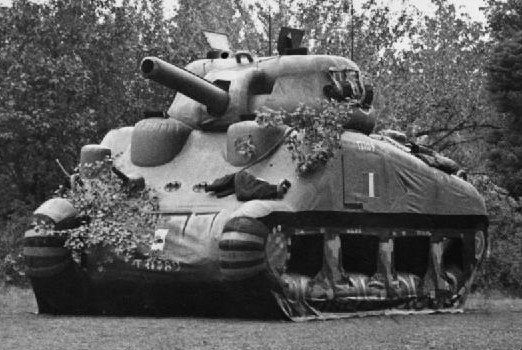Ghost Army: The army that routed the Germans

Bill Blass was one of them. Just like Ellsworth Kelly. And Arthur Singer. And Art Kane. Before these men embarked on the artistic careers that would bring them fame, they served together in World War II. But they were a particular type of soldier, serving in a particular type of unit: Blass and his brothers-in-arms were recruited from art schools and advertising agencies. They were sought after for their acting skills. They were selected for their creativity. They were soldiers whose most effective weapon was art.
Their job was nothing more, nothing less than to deceive Hitler.
Blass and his cohort were members of the 23rd Special Headquarters Troops, an elite force whose specialty was "tactical deception" . They are now better known as the "Ghost Army". The members of the 23rd were, essentially, the builders of the modern Trojan Horses of World War II.
Their wooden horses took the form of inflatable tanks . And rubber planes . And elaborate costumes . And radio codes. And loudspeakers that broadcast pre-recorded soundtracks in the forests of France.

These "advanced technology" props were surprisingly effective, doing what all good theatrical props do: stage a believable scene. The Phantom Army, some 1,100 men in all , ended up staging over twenty battlefield deceptions between 1944 and 1945, beginning in Normandy two weeks after D-Day and ending in the Valley of the Rhine. Many of these performances -- "illusions", as the men rightly preferred to call them -- took place a few hundred yards from the front lines.
And they relied on what the Ghost Army impressively called "the atmosphere" - creating the overall impression of an all-pervasive military force. The soldiers of the Phantom Army were Potemkin villages, personified. They posed as members of other units (units that were actually deployed elsewhere) by sewing division patches onto their uniforms and painting the insignia of other units onto their vehicles. The army sent a few of its members to drive tarpaulin trucks - sometimes as few as two such trucks - in convoys in loops that gave the impression (sorry, "the illusion") that an entire infantry unit was transported.
As Jack Masey, who was recruited into the Ghost Army at the age of 18, recalls: "We were told we were going to use inflatable equipment to try to trick the Germans into thinking we were a real army. , when we were actually, I guess, a rubber army."
The Rubber Army used their drama to their advantage. She staged a series of "traveling shows": elaborate plays intended to intimidate and/or confuse the Axis. Its members put their theatrical skills to good use, playing roles, designing soundscapes and creating sets. They were sent to French cafes near the front to spread gossip among any spies who might be there - to, as one ghoster put it, "order omelettes and talk freely". Some Shadow Army actors also played the role of Allied generals, disguising themselves as officers and visiting towns where enemy spies were likely to see them.
The role of the Ghosters was, in a sense, to cause chaos and confusion. And they played it not only using visual trickery , but also with what they called "sonic trickery". With the help of Bell Labs engineers, a team from the unit's 3132 Signal Service Company Special traveled to Fort Knox to record the sounds of armored and infantry units on wire recorders (the predecessors of the tape recorders) which were state of the art at the time. In the theater, they would then "mix" these sounds to match the atmosphere they wanted to create, playing their fake soundtracks with powerful amplifiers and speakers mounted on half-tracks - a combination so effective that sounds could be heard up to several meters away.

The unit's special signals company also created what it called "Spoof Radio", in which its actors posed as the radio operators of real units. Ghosters also mimicked outbound operators' methods of sending Morse code, creating the illusion to Axis armies that the Allied unit was nearby when in fact it had already left the area. The Ghost Army's sonic illusions, in this case, were so convincing that they fooled the Axis. Sally, the radio propagandist, led them to believe that an entire Allied division was preparing for battle in a location that actually contained, at the time, no troops.
All this to serve the ultimate illusion of the Allies: that their military force was bigger and more powerful than it really was. (Part of the Shadow Army's effectiveness came from the fact that it used real tanks and artillery pieces in addition to fake ones, so that the mannequins in the distance seemed to blend in). It is estimated that today the Shadow Army has saved the lives of tens of thousands of soldiers through its deceptions, and has been instrumental in several Allied victories in Europe. She accomplished all of this by taking, among other things, "the art of war" wonderfully at face value.

The story of the Phantom Army was classified as a military secret until it was declassified in 1996. Today, it is the subject of a documentary, the Phantom Army. Director Rick Beyer sees the unit's antics as a sign, in part, of how much we still have to learn about World War II. "It's a great example," he told the Smithsonian magazine, "of how many fantastic, amazing, mind-blowing stories there are still 70 years after the end of World War II."
It's hard to imagine a more mind-bending story than that of the Phantom Army's military magic, though. "I used to call us," said one of his soldiers, "the Cecil B. DeMille Warriors."
1 comment
Super article !!